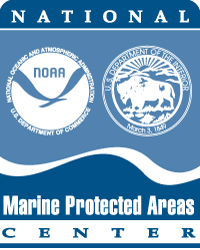Executive Order 13158 defines "MPA" as, "Any area of the marine environment that has been reserved by Federal, State, territorial, tribal or local laws or regulations to provide lasting protection for part or all of the natural and cultural resources therein."
Without further clarification, the key terms of "area," "marine environment," "reserved," "lasting," and "protection" found in the MPA definition are subject to a range of interpretations and lead to an uncertain scope for the National System. Without clear definitions for these five key terms, identifying the sites that should be considered MPAs for the purposes of participating in the national system would be unclear and efforts to fully implement the Order would be fragmented, diffused, and ultimately unsuccessful.
The definitions of key terms for "MPA" listed below were guided by recommendations from stakeholders, including the MPA Federal Advisory Committee. The Order's definition of MPA, when taken together with the definitions of the five key terms of "area," "marine environment," "reserved," "lasting," and "protection," and the "Additional National System MPA Criteria" listed below represent the complete set of criteria for determining the participation of existing MPA sites, programs and/or systems in the national system. For the purposes of the National System of MPAs, the key terms of the MPA definition are defined as follows:
Area
Must have legally defined geographical boundaries, and may be of any size, except that the site must be a subset of the United States federal, state, local or tribal marine environment in which it is located. Application of this criterion would exclude, for example, generic broad-based resource management authorities without specific locations and areas whose boundaries change over time based on species presence. The area must be one over which the U.S. has jurisdiction, consistent with international law.
Marine environment
Must be: (a) ocean or coastal waters (note: coastal waters may include intertidal areas, bays or estuaries); (b) an area of the Great Lakes or their connecting waters; (c) an area of submerged lands under ocean or coastal waters or the Great Lakes or their connecting waters; or (d) a combination of the above. The term "intertidal'' is understood to mean the shore zone between the mean low water and mean high water marks. An MPA may be a marine component part of a larger site that includes uplands; however, the terrestrial portion is not considered an MPA. For mapping purposes, an MPA may show an associated terrestrial protected area.
For the purposes of the national system, NOAA and DOI intend to use the following definition for the term "estuary": "part of a river or stream or other body of water having unimpaired connection with the open sea, where the sea water is measurably diluted with fresh water derived from land drainage, and extending upstream to where ocean derived salts measure less than 0.5 parts per thousand during the period of average annual low flow.'' Application of this criterion would exclude, for example, strictly freshwater sites outside the Great Lakes region that contain marine species at certain seasons or life history stages unless that site is a component of a larger, multiunit MPA.
Upon request, the agencies will work with individual federal, state and tribal MPAs and programs to examine unique conditions which may affect applicability of the term "estuary" or "coastal waters" for sites that have national or regional significance or representativeness.
Estuarine-like sites on tributaries of the Great Lakes will be considered for inclusion if they are located within the eight-digit U.S. Geological Survey cataloging unit adjacent to a Great Lake or its connecting waters.
Reserved
Must be established by and currently subject to federal, state, local, or tribal law or regulation. Application of this criterion would exclude, for example, privately created or maintained marine sites.
Lasting
For natural heritage and cultural heritage MPAs, the site's authority must clearly state its intent to provide permanent protection. This definition recognizes that subsequent to establishment, MPA designation and level of protection may change for various reasons, including natural disasters that may destroy or alter resources or changes in societal values. Should any of these changes occur, the status of the MPA relative to the national system could be re-evaluated.
Sites and/or protections that must have a specific legislative or other administrative action to be decommissioned shall be considered to have been established with the intent to provide permanent protection. This would include, for example, sites that have a requirement for periodic renewal contingent on evaluation of effectiveness, with no specified expiration date.
For sustainable production MPAs, the site must be established with the intent at the time of designation to provide, at a minimum, the duration of protection necessary to achieve the mandated long-term sustainable production objectives for which the site was established.
For all MPAs, the site must provide the same level and type of protection at a fixed location and fixed and regular period of any duration during a year.
Protection
Must have existing laws or regulations that are designed and applied to afford the site with increased protection for part or all of the natural and submerged cultural resources therein for the purpose of maintaining or enhancing the lasting conservation of these resources, beyond any general protections that apply outside the site.
Application of this criterion would exclude restricted areas that are established for purposes other than conservation. The term would not include, for example, areas closed for navigational safety, areas closed to safeguard modern human-made structures (e.g., submarine cable no-anchor zones), polluted shellfish-bed closure areas, areas closed to avoid fishing gear conflicts, and areas subject to area-based regulations that are established solely to limit fisheries by quota management or to facilitate enforcement.
 Marine Protected Areas
Marine Protected Areas